For every soccer player, from the professional athlete charging through a championship game to the weekend warrior enjoying a pickup match, the right gear is crucial for both performance and comfort.
One element that rarely gets the spotlight, yet is integral to every stride, pass, and goal, is the soccer cleat—often the underappreciated asset of the soccer world.
Soccer cleats, known as football boots in places where "football" is the word for soccer, are much more than just footwear. They are the cornerstone of a soccer player's arsenal, meticulously designed to offer traction, speed, and maneuverability on the field. Whether referred to as soccer shoes or cleats, these essential pieces of equipment come in a variety of types, each tailored for specific playing conditions and styles.
This article will peel back the layers of soccer cleats, diving into their design, purpose, and the impact they have on a player's game.
From the significance of studs for traction to the artful consideration of materials for maximum performance and comfort, we uncover everything you need to know about these pivotal pieces of soccer gear.
Key Takeaways
- Soccer cleats, or football boots, are specialized footwear designed to enhance a player's performance by offering superior traction, speed, and control on the field.
- The choice between different types of cleats—firm ground, soft ground, artificial grass, and others—should be informed by the playing conditions and personal play style.
- Material, fit, and the technology incorporated into cleats can significantly influence a player's comfort and gameplay, affecting every touch of the ball.
- Understanding the features of soccer cleats, including the stud configuration and the importance of grip and traction for various pitch conditions, is essential for selecting the right pair.
- Soccer cleats have evolved over the years, with advancements in technology adding new dimensions to player performance and safety on the pitch.
Whether you're about to step onto the pitch for the first time or are a seasoned player looking to refine your equipment arsenal, understanding the importance and intricacies of soccer cleats is a game-changer.
Let's lace up and discover how the right pair of cleats can shift your performance from good to great.
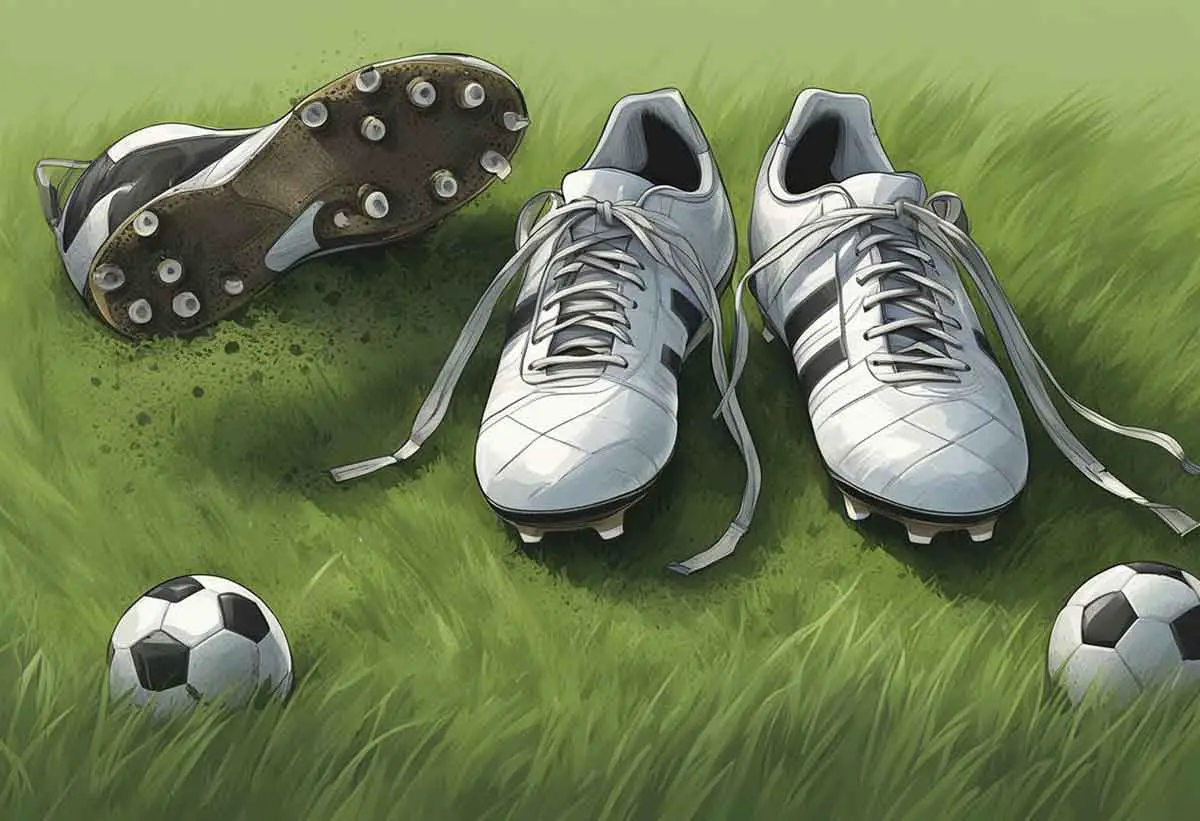
What Are Soccer Cleats? Understanding the Cornerstone of Every Player’s Arsenal
For those of us with a profound passion for soccer, the conversation often turns to the sport's most essential gear—soccer cleats.
Across the pond in England, enthusiasts might refer to them as football boots, a nod to the rich cultural heritage and history ingrained in the sport.
While some may use soccer shoes and cleats interchangeably, it's important to understand the distinction. Though every pair of soccer cleats falls under the broad category of soccer shoes, not all soccer shoes boast cleats.
The hallmark of a true soccer cleat lies in its studs—or cleats—on the underside, which are pivotal for gaining traction on the field. These studs empower players to execute those signature sharp turns and sudden stops without the fear of slipping.
Let's dive into the essentials of soccer cleats:
- Designed with Purpose: Cleats are meticulously crafted with soccer in mind.
- Studs for Traction: The bottom protrusions are more than just a feature; they're a necessity for gripping the turf, enabling dynamic play.
- Material Choices: Options range from leather to synthetic, each selected for its durability and performance-enhancing qualities.
My experiences on the field have taught me that choosing the right cleats isn't just about preference—it's a strategic decision.
The right pair not only boosts your performance but also minimizes the risk of injuries, essential for any player keen on fully enjoying the game and honing their skills.
Whether it's a young enthusiast in America trying on their first pair of cleats or a veteran player in the UK slipping into their beloved football boots, selecting the right pair transcends mere footwear.
It represents an essential step towards mastering the beautiful game. So, when the time comes to pick a new pair, remember that understanding the terrain and recognizing your unique play style can significantly influence your choice.
Types of Soccer Cleats
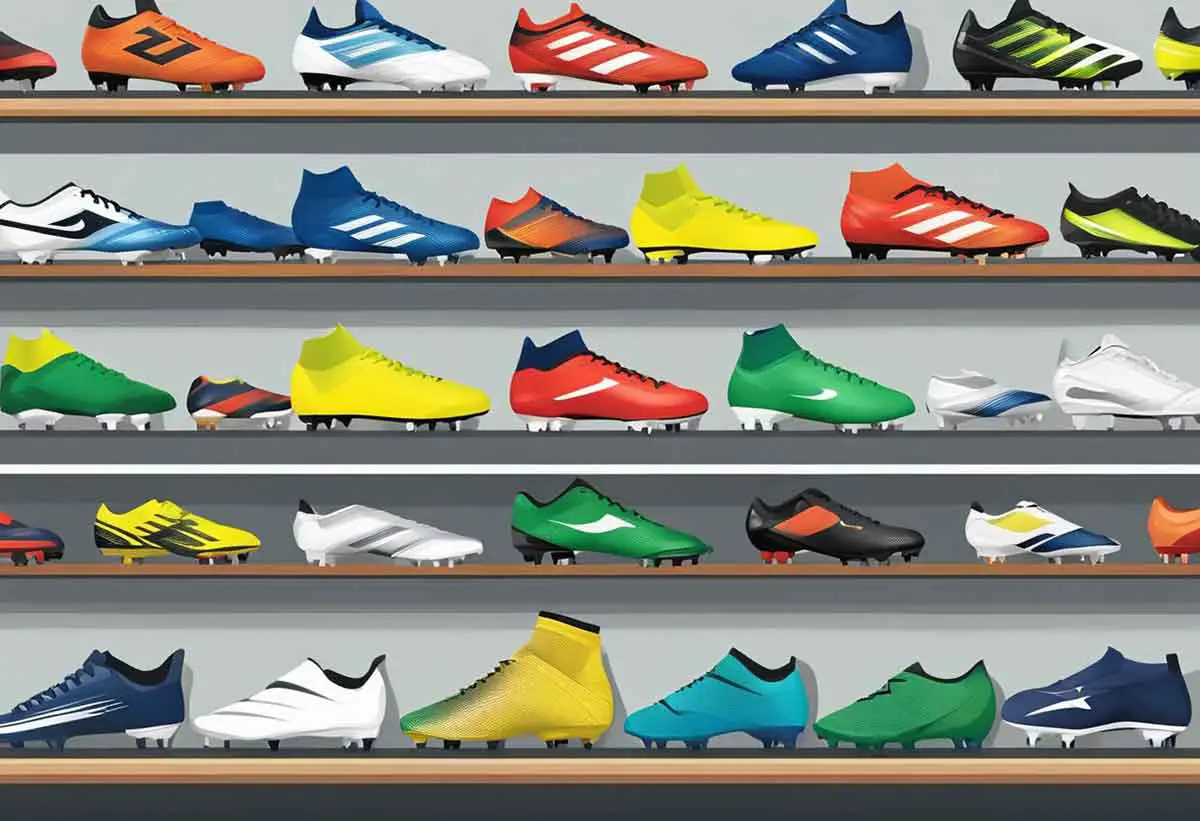
For every soccer devotee, understanding the nuances of soccer cleats is crucial to optimizing match-day performance.
The right cleat choice can significantly enhance your play, tailored specifically to the playing conditions and the surface you're gracing.
Let’s break down the variety of soccer cleats designed to elevate your game in different environments.
Firm Ground Cleats
Firm Ground (FG) cleats remain unparalleled for athletes on natural grass fields, spanning dry to slightly moist conditions.
Celebrated for their adaptability, these cleats usually feature either conical or blade-shaped studs, crafted to ensure top-notch traction and steadiness — the crux of any formidable player's arsenal.
Suited for both beginners and intermediates, they're a versatile choice across most field types and weather scenarios.
Soft Ground Cleats
Soft Ground (SG) cleats shine on those rain-drenched days, making slick fields manageable.
Their hallmark is longer, often changeable metal studs, enabling deep penetration into soggy terrain for robust grip and slip prevention.
For those who regularly battle in wet conditions, SG cleats are a wise investment.
Hard Ground/Multiground Cleats
Hard Ground (HG) or Multiground (MG) cleats are tailored for hard, dry grass fields or the various ever-evolving synthetic grass surfaces.
These variants sport a mix of circular and blade-shaped studs, offering enhanced stability and endurance, perfect for artificial grass fields requiring a unique tactile approach.
Artificial Grass Cleats
Artificial Ground (AG) cleats, specifically fashioned for modern artificial grass, feature numerous shorter studs.
These are designed to spread weight more evenly, fostering confident, swift maneuvers without the stud-induced pressure, offering a comfy fit and increased cushioning for added protection on synthetic turfs.
Turf Soccer Shoes
Channeling a blend of performance and comfort, Turf Soccer Shoes (TF) cater to synthetic grass and thin carpet turf with numerous compact studs for superior traction.
These shoes ensure firm footing and agility on the harder, more textured artificial surfaces.
Indoor Soccer Shoes
For the indoor enthusiast, Indoor Soccer Shoes (IN or IC) offer an exceptional advantage with their distinctive gum rubber soles that grip smooth indoor courts without marking — ideal for players seeking precision in every movement on flat, polished arenas.
Key Features of Soccer Cleats
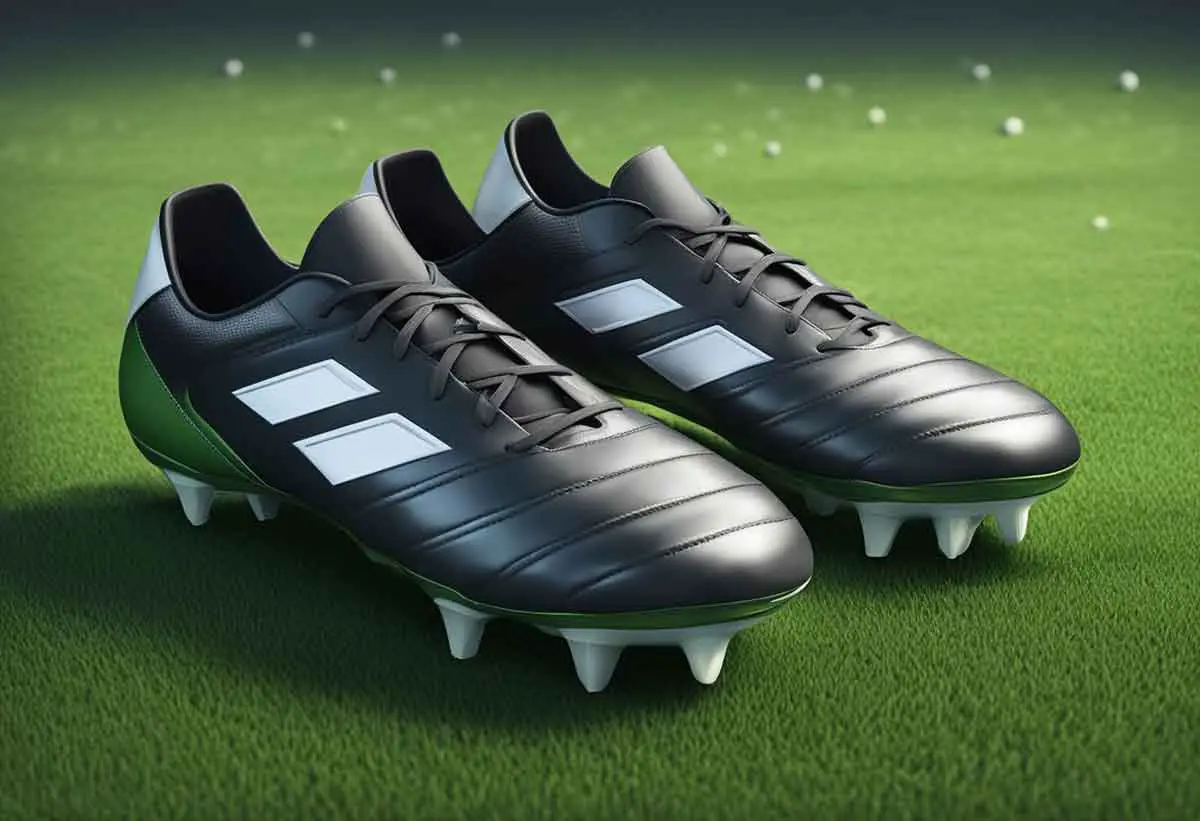
Before we delve deep into what sets apart an ordinary kick from a match-winning maneuver, let's tie up some vital knowledge about soccer cleats. Understanding these pivotal features can dramatically transform your game from the ground up.
Material and Durability
At the core of every great soccer cleat is its material—the decisive factor in both durability and performance.
Leather options, such as K-Leather, offer unmatched comfort and a tailor-fit adaptability, molding perfectly to the foot over time.
Synthetic materials, on the other end, strike with their impressive water resistance and low-maintenance appeal.
Knit fabrics have recently made a splash, weaving their way into the market with a promise of a snug, almost sock-like fit that doesn’t compromise on durability.
Stud Types and their Science
The studs underfoot aren't just there for decoration; they're integral for peak performance on the pitch. Matching the stud design with your play style and the fields you dominate, helps ensure that.
Conical studs excel in quick ground penetration and swift release, enhancing stability and ease of movement.
Bladed studs aim to maximize traction, aiding in speedy sprints and sudden halts.
The Importance of Fit and Comfort
Never underestimate the power of a perfectly fitted cleat.
A snug fit provides essential support, locking your foot in place for precise control, minimizing internal slippage, and significantly reducing the threat of blisters.
Combine this with adequate padding and cushioning, and you've got a recipe for comfort that lasts the entire 90 minutes and beyond.
Remember, a cleat that blends seamlessly with your foot allows for natural, unrestricted play.
Mastery of Traction and Grip
The defining moments on the field often come down to traction and grip.
These elements are paramount for executing sharp, agile movements and withstanding the rigor of diverse playing conditions.
The outsole material, typically rubber or a comparable compound, is chosen explicitly for its ability to grasp the playing surface securely.
Cleats designed with the right traction in mind enable you to unleash your full potential, playing with unwavering confidence regardless of the weather or terrain.
What Are Soccer Cleats Made Of? What Are their Components?
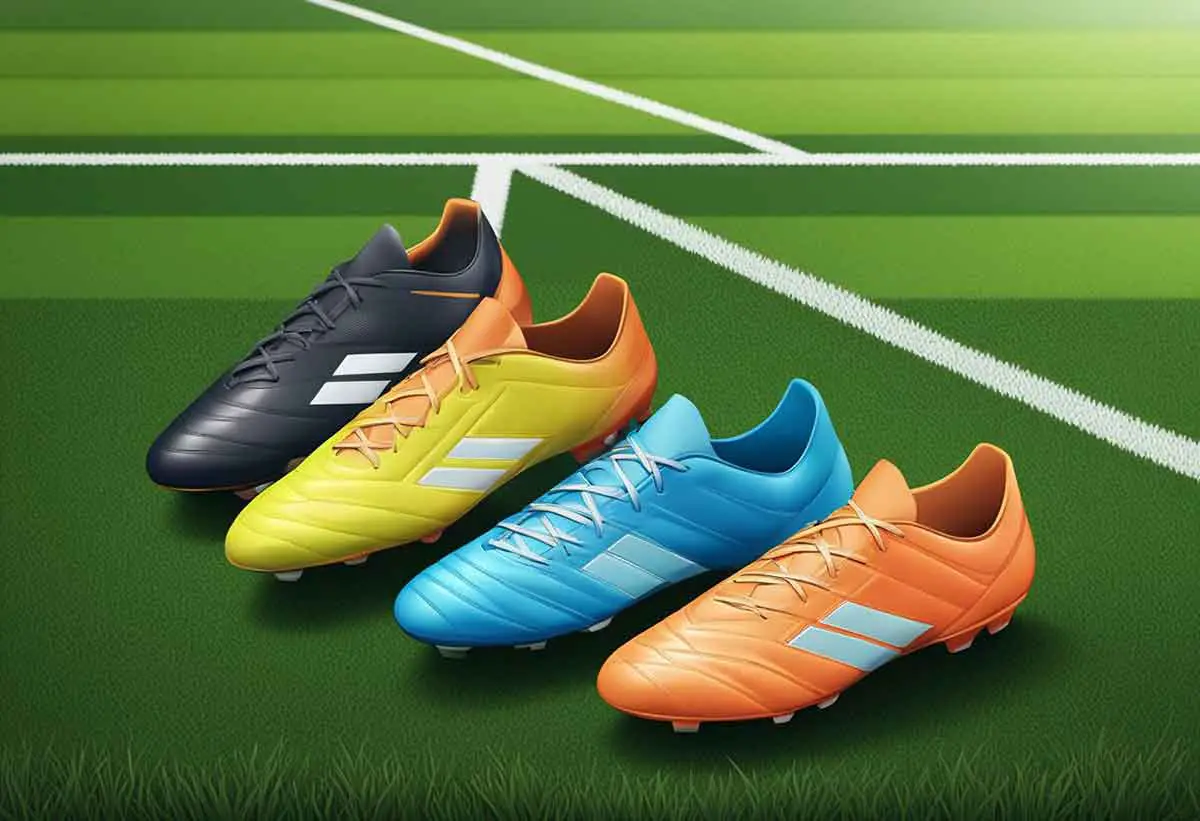
Soccer cleats aren't just footwear—they're precision-crafted tools designed to elevate every aspect of a player's game on the field.
Here, I’ll dissect a soccer cleat, from the upper layer down to the sole, to appreciate how each component combines comfort, control, and traction.
The Upper
The upper of a soccer cleat is where magic meets material.
It's the section that snugly encases the top of the foot, extending to the vamp—the forefoot area most involved with ball contact.
Whether it's made from supple leather or advanced synthetic materials, the upper's quality directly affects your “feel”, you tactile connection with the ball, dictating the finesse of dribbling, passing, and shooting.
The Insole
Think of the insole as your foot's best friend during the relentless pursuit of victory.
A well-crafted insole, often fashioned from comfortable foam, molds to the foot's natural contours.
This personalized support can be the difference between fatigue and enduring comfort throughout the physical demands of a full match, cushioning every step and sprint.
The Midsole
The midsole might play a quieter role in the cleat's anatomy, but its impact on the game speaks volumes.
Generally thinner than what you might find in running shoes and designed to be sleek yet effective, the midsole's primary function is shock absorption, minimizing the foot's exposure to impact during play.
This subtle layer of protection keeps you focused on the game, not the ground.
The Outsole
In the realm of soccer cleats, the outsole is your direct link to the ground beneath your feet.
A sturdy yet flexible outsole provides a balance between movement and stability.
The material choice for the outsole—as well as its compatibility with the stud configuration—is pivotal for maximizing traction and agility on the field.
Stud Configuration
The strategic stud configuration plays a starring role in fine-tuning your movements.
With a variety of designs—from the versatile conical studs that support swift multidirectional movement to the bladed studs engineered for explosive sprints and stops—each configuration is meticulously tailored to enhance performance on specific surfaces.
The Heel and Collar
Rounding out the anatomy of the soccer cleat, the heel and collar focus on fit and safety.
A robust heel counter keeps the foot securely in place, a critical factor in preventing injuries due to slipping.
The collar, often cushioned, surrounds the ankle with supportive comfort, fostering stability and confidence with every pivot and turn.
Are Cleats Required for Soccer?
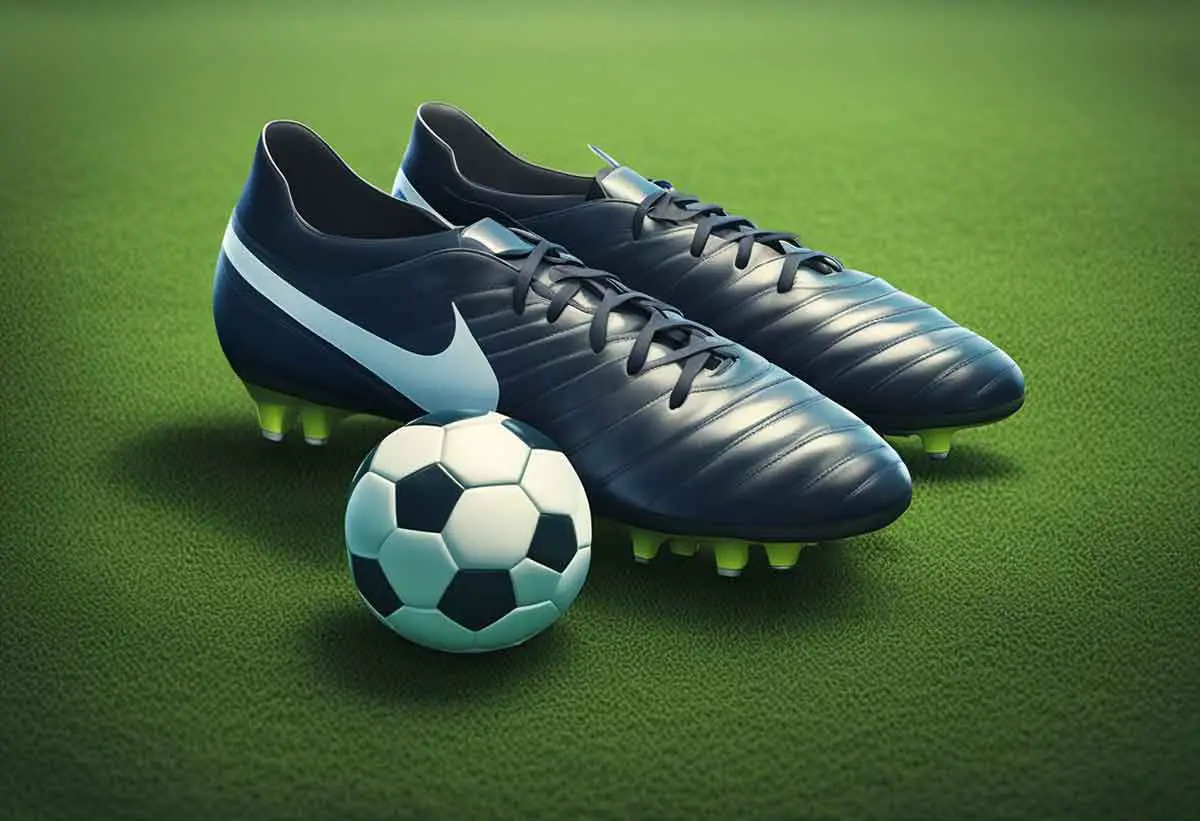
In my adventures with Soccermodo and as a fervent follower of the beautiful game, one query that often surfaces amongst new enthusiasts is the essentiality of soccer cleats.
Reflecting on my initial days and aligning with the guidelines from reputable soccer sources, let's demystify this gear's role on the pitch.
While soccer's governing rules don't impose a strict requirement for soccer cleats, emphasizing that players need to don appropriate footwear, the absence of a mandate for cleats specifically means one could technically play in any athletic shoe.
This flexibility suggests that if your go-to cleats are not at hand, you're not sidelined from the game.
However, my personal journey and observations underline the unparalleled advantages of cleats:
- Traction: The prime feature of soccer cleats is their ability to offer unmatched grip, especially on slippery or lush fields. This attribute is indispensable for executing precise cuts, sprints, and halts without the risk of an unintended tumble.
- Performance Enhancement: The strategic design of soccer cleats, aimed at the sport's unique demands, significantly bolsters my performance. When it comes to intricate passes or long-range goals, the right cleats edge me closer to perfection, allowing focus on technique rather than maintaining equilibrium.
- Safety First: Beyond the embarrassment of slips, the inherent risk of injury looms large. Soccer cleats are designed with stability in mind, serving as a crucial preventive measure against mishaps.
Impact of Soccer Cleats on Performance
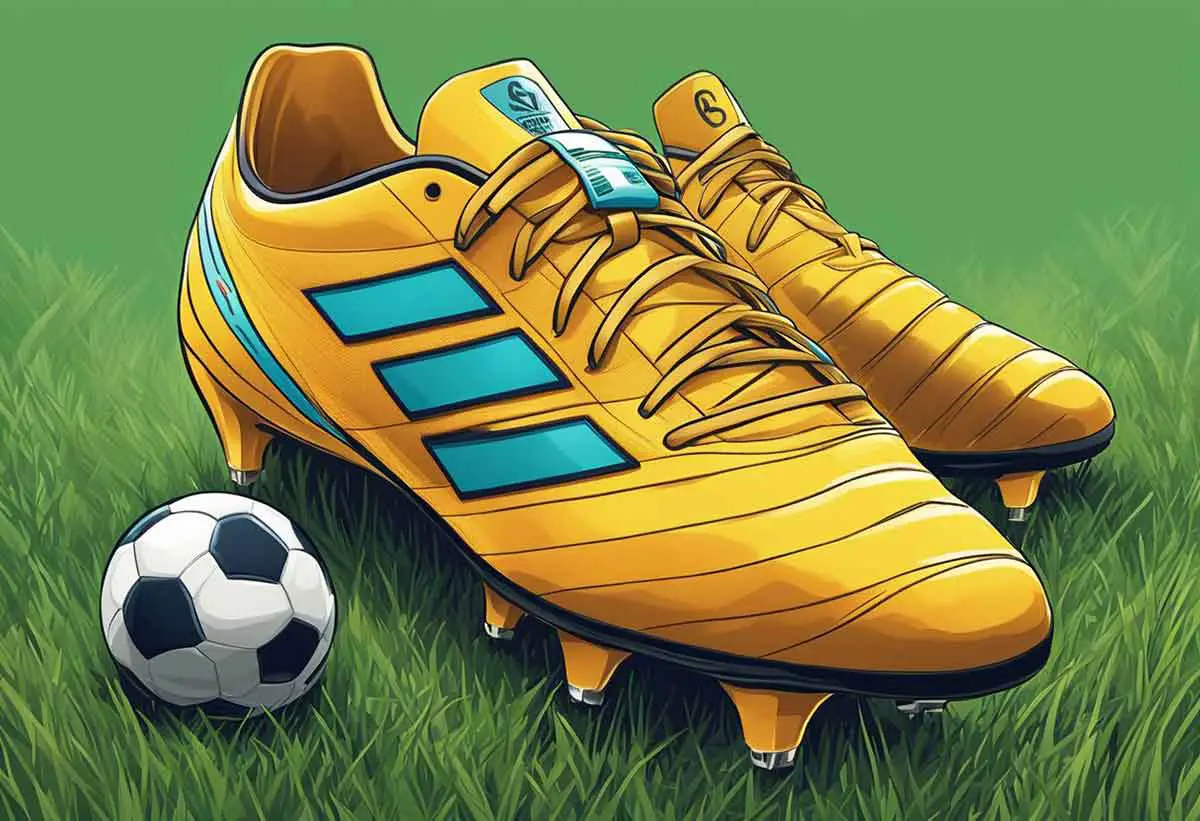
As a fervent soccer enthusiast and seasoned writer for Soccermodo, my fascination extends to every piece of equipment that ties (quite literally) into the sport’s heart. At the forefront? Soccer cleats.
Beyond their stylistic appeal, soccer cleats stand as a testament to form meeting function, deeply influencing performance on the field.
The carefully engineered design of modern cleats, some featuring advancements like Flywire technology, significantly bolsters stability, providing a secure footing that's critical during those game-changing moments.
Ball control is another arena where the impact of cleats is palpably felt. The strategic texturing on the upper part of cleats can transform the way a player interacts with the ball, from nuanced dribbling to powerful strikes.
The right pair of cleats can mean the difference between a goal that's celebrated and a shot that's lamented.
So, why consider cleats an indispensable part of your soccer arsenal?
- Foot Protection: Sporting robust materials, cleats act as a first line of defense against the physical challenges of the game.
- Traction and Grip: High-quality cleats ensure players can maintain their footing, a non-negotiable necessity across various pitch conditions.
- Elevated Performance: Leveraging lightweight materials and innovative design, cleats can unlock newfound levels of speed and agility.
Best Soccer Cleat Brands: Highlighting the Titans
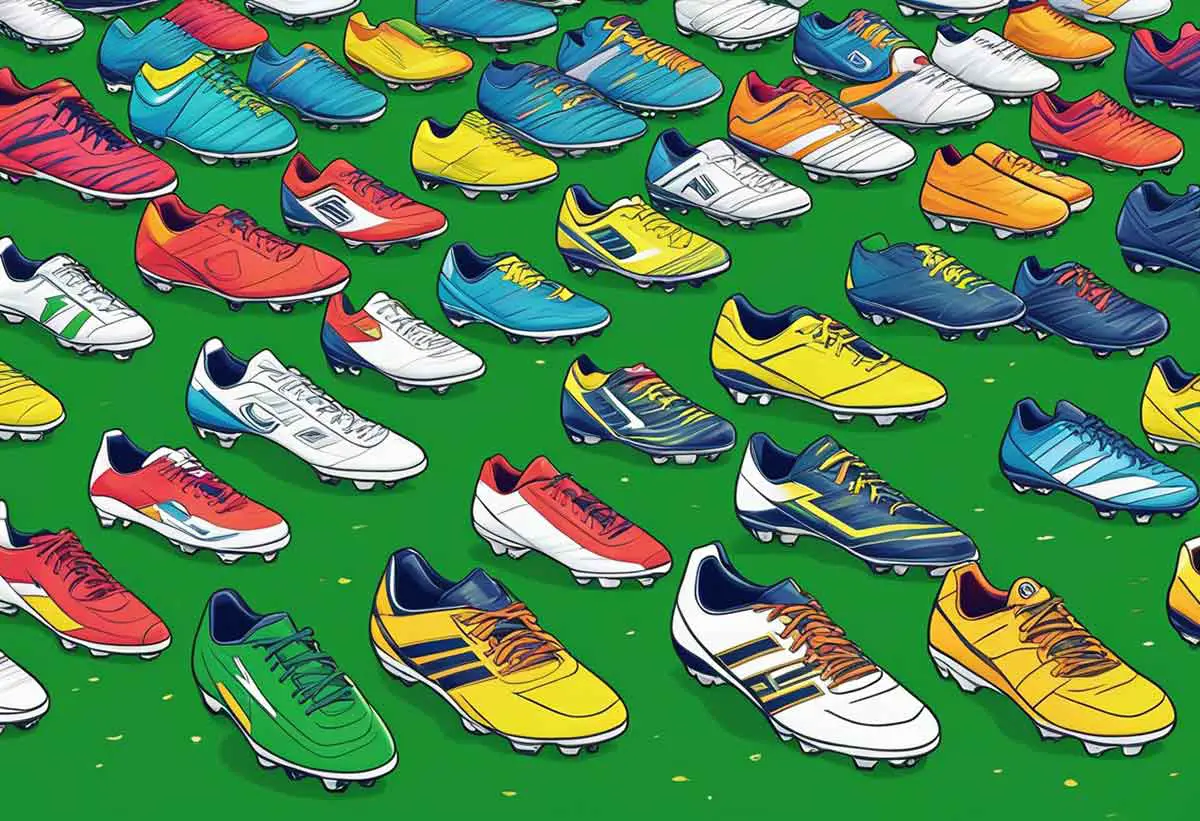
Through my journey in chronicling the beautiful game, the role of reliable soccer cleats has become unmistakably clear.
Brands like Nike, Adidas, and Puma have stood out, consistently offering quality that caters to both the professional and amateur athlete.
These heavy-hitters in the soccer cleat realm have consistently demonstrated their prowess in enhancing player performance through innovative design, material selection, and a deep understanding of the athlete’s needs.
Nike
Nike has reshaped the landscape of soccer footwear with its pioneering designs. The brand’s Mercurial series, a favorite among legends like Cristiano Ronaldo, exemplifies innovation.
Crafted for velocity, these cleats feature lightweight materials and ground-breaking traction patterns, setting the standard for speed-oriented footwear.
Adidas
Adidas is synonymous with soccer heritage. Wearing Adidas cleats feels like tapping into a legacy of excellence, underscored by iconic models such as the F50 and Adipure.
Known for their precise fit and ball control, Adidas cleats reflect the brand’s commitment to marrying comfort with unmatched on-field performance.
Puma
Puma's influence in soccer cleat manufacturing is undeniable, crafting classics like the Puma Kings and leading the charge in technological advancements.
The Puma Men's Future Z 1.4 FG showcases this blend of innovation and tradition, catering to players seeking a balance between flexibility and stability.
The Evolution of Soccer Cleats: A Glimpse into Technological Breakthroughs
Over my years as a player and a dedicated follower of soccer, the transformation of soccer cleats through technological innovation has been nothing short of remarkable.
This evolution is not merely a testament to aesthetic progression but a revolution in enhancing player performance across every level of the game.
Leading brands in the sports equipment sphere have been at the forefront of releasing soccer cleats that prioritize lightweight designs and materials, propelling players to new heights of speed and agility without the encumbrance of heavier footwear.
For instance, innovations like Nike's Flyknit technology have set a benchmark in combining strength, flexibility, and lightness, redefining what athletes can expect from their gear.
Here's a quick overview of some pioneering features:
- Embedded Sensors: A futuristic addition to the soccer cleat landscape, these sensors gather vital performance data, allowing players to analyze and refine their game.
- Anti-Clog Technology: Perfect for the unpredictability of weather and field conditions, the anti-clog traction ensures cleats remain free from mud and water accumulation, a notable advance by Nike in maintaining traction under adverse conditions.
- Hybrid Stud Configurations: The blending of bladed and conical studs is a strategic masterpiece, offering optimized traction that supports seamless pivots and abrupt stops, underlining the importance of stud configuration in responding to diverse field dynamics.
The goal is to craft cleats that not only conform to the player's foot and playing style but also underscore a personalized playing experience. This ambition harks back to the pioneering days of leather cleats (in the early 1900s) but with a focus on adaptation and comfort that leather alone couldn't offer.
When I equip myself with cleats imbued with smart technology, it's as if I'm stepping into a new dimension of competitive edge.
FAQ: Frequently Asked Questions
Why are materials in soccer cleats important for performance?
Materials play a pivotal role in the functionality of soccer cleats, influencing ball interaction and on-field agility. Leather, admired for its adaptability and touch, conforms to the foot for improved ball control. Synthetic materials, by contrast, excel in providing lightness for swift movements. The material choice affects dribbling precision and passing accuracy, crucial elements for competitive play.
How do soccer cleats enhance a player's game on the field?
Cleats enhance a player's game by offering essential traction for explosive movements and pivotal stops. This directly impacts a player's stability during dynamic actions, fostering better acceleration and maneuverability. It's not solely about slip prevention; it's about empowering confidence with every stride.
What are the key differences between youth and adult soccer cleats?
The primary differentiator is the sizing and design tailored to accommodate growing feet in youth cleats, which often feature softer materials and additional support. Adult cleats, meanwhile, become more specialized, focusing on performance-enhancing features like optimized stud configurations for various playing environments.
Why are there variations in soccer cleats for different genders?
Cleats are designed to fit different foot anatomies appropriately. Compared to men’s, women's cleats are generally narrower, with a heel-to-toe ratio crafted to fit the typical foot's structure and size of female players. This specificity ensures both comfort and performance are not compromised due to ill-fitting footwear.
How do the soles of soccer cleats affect play on various pitch conditions?
The sole design, particularly the stud configuration, is tailored for specific pitch types—Firm Ground (FG) cleats suit dry, hard surfaces, whereas Soft Ground (SG) options with longer, metal-tipped studs are ideal for wet and muddy conditions. Choosing suitable soles can dramatically affect grip, reducing injury risks, and optimizing performance.
Is it necessary to wear soccer cleats in casual or recreational play?
While not mandatory, cleats offer significant advantages in traction and game enjoyment, even in leisurely settings. The decision usually boils down to personal preference and the desire for an enhanced playing experience.
Can football cleats be used for soccer?
Football cleats cannot be used for soccer. This decision, guided by player safety rules from the International Football Association Board (IFAB), highlights the key differences in design, such as longer, sharper studs and the presence of a toe stud in football cleats, which could pose injury risks in soccer. The distinct build of football cleats impacts performance on the soccer field, making them unsuitable for soccer use.
For a more detailed explanation of the differences and the specific reasons why football cleats aren’t allowed in soccer, check out our informative article: Can Football Cleats Be Used for Soccer? Everything You Need to Know.
Can baseball cleats be used for soccer?
Using baseball cleats for soccer is not advisable. Baseball cleats are designed with a toe spike that can pose a safety risk in soccer, where close contact and rapid movements are common. While it may be tempting to repurpose gear, opting for soccer-specific cleats ensures the right features for agility, control, and player safety on the pitch.
For a more detailed explanation of the differences and the specific reasons why using baseball cleats in soccer is not recommended, check out our informative article: Softball Cleats vs Soccer Cleats Key Differences: Can You Wear Them for Soccer?.

